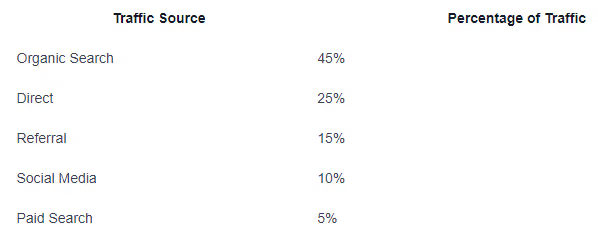How Well a Website Measures Success
KPIs are measurable values that indicate how well a website is performing in relation to its objectives, targets, or industry peers.


How Well a Website Measures Success
Understanding Website Success
To gauge the success of a website, it's important to understand the concept of Key Performance Indicators (KPIs). KPIs are measurable values that indicate how well a website is performing in relation to its objectives, targets, or industry peers. They serve as a bridge between actual business operations and goals, allowing companies to set objectives and monitor progress toward those objectives.
Key Performance Indicators (KPIs)
KPIs are essential for assessing the success of a website. They provide quantifiable information that is useful in strategic planning, problem identification, and ensuring operational excellence. By tracking KPIs, website owners can gain insights into specific areas that need improvement and make informed decisions to optimize their website for long-term success.
Some common KPIs used to measure website success include:
Lead Conversion Rate
The lead conversion rate is a crucial KPI that measures the percentage of website visitors who take a desired action, such as making a purchase, submitting a contact form, or subscribing to a newsletter. A higher lead conversion rate indicates that the website is effectively converting visitors into potential customers or leads.
A good lead conversion rate can vary depending on the industry, but on average, a conversion rate between 2% and 5% is considered average, 6% to 9% is above average, and anything over 10% is considered good. Improving the lead conversion rate involves optimizing various aspects of the website, such as the user experience, call-to-action placement, and persuasive copywriting.
By tracking the lead conversion rate, website owners can determine the effectiveness of their marketing and sales strategies, identify areas for improvement, and make data-driven decisions to enhance the website's performance.
Understanding these KPIs is crucial for evaluating the success of a website. However, optimizing a website requires more than just monitoring KPIs. It also involves implementing strategies to enhance mobile optimization, improve website speed, and provide a seamless user experience. In the following sections, we will explore these optimization strategies in more detail.
Optimization Strategies
To ensure the success of a website, optimization strategies play a crucial role. By focusing on mobile optimization, website speed, and user experience (UX), website owners can improve their visibility, engagement, and overall performance.
Mobile Optimization
In today's digital landscape, mobile devices account for a significant portion of global traffic, with approximately 58.67% of traffic coming from mobile devices. This emphasizes the importance of mobile optimization for websites. Search engines now prioritize ranking mobile-supported sites, making mobile optimization vital for SEO.
Mobile optimization involves creating a responsive design that adapts to different screen sizes and resolutions. This ensures that users have a seamless and enjoyable experience when accessing the website on their smartphones or tablets. A well-optimized mobile site not only improves SEO performance but also enhances user satisfaction, leading to a more successful online presence.
Website Speed
Website speed has a significant impact on both SEO and user experience. Optimizing the speed of a website not only enhances its SEO performance but also improves user satisfaction, ultimately leading to a more successful online presence.
When a website loads quickly, users are more likely to stay engaged and explore its content. On the other hand, a slow-loading website can frustrate users, leading to increased bounce rates and decreased user engagement. Search engines also take website speed into account when determining search rankings, making it essential to optimize website speed for better visibility and higher engagement.
To improve website speed, various techniques can be employed, such as optimizing image sizes, reducing unnecessary plugins, leveraging browser caching, and minimizing server response time. By implementing these strategies, website owners can create a faster and more efficient browsing experience for their visitors.
User Experience (UX)
User experience (UX) plays a pivotal role in a website's ranking and visibility in search engines. Search engines value websites that prioritize providing a superior user experience, as it leads to higher engagement and better user satisfaction.
Creating a positive user experience involves designing a website that is easy to navigate, visually appealing, and user-friendly. Intuitive site navigation allows visitors to find the information they need quickly and easily, enhancing their overall browsing experience. Incorporating visually appealing elements, such as high-quality images and videos, can also captivate users and encourage them to spend more time on the site.
Reducing bounce rates is another important aspect of optimizing user experience. By considering factors such as page load time, content relevance, and overall website usability, website owners can create a more engaging and satisfying experience for their visitors.
By focusing on mobile optimization, website speed, and user experience (UX), website owners can optimize their sites for success. These strategies not only enhance SEO outcomes but also improve visibility, engagement, and overall user satisfaction.
Enhancing User Engagement
To measure the success of a website, it's crucial to focus on enhancing user engagement. User engagement refers to the level of interaction and interest displayed by visitors on a website. In this section, we will explore three key aspects that contribute to enhancing user engagement: site navigation, visual elements, and bounce rate considerations.
Site Navigation
Intuitive and easy site navigation is crucial for a positive user experience, ultimately contributing to user retention. Implementing structured and easy-to-follow navigation systems can enhance accessibility and ease of use throughout the site. Consider incorporating elements such as sticky menus or mega footers to ensure that users can navigate through your website effortlessly [3].
By organizing the navigation in a logical and hierarchical manner, users can quickly find the information or products they are seeking. Clear labels, dropdown menus, and search functionality can also enhance the navigation experience. Effective site navigation not only improves user engagement but also aids in search engine optimization by providing a seamless experience for both users and search engine crawlers.
Visual Elements
Visual elements, including color theory, images, and videos, play a crucial role in shaping user engagement on a website. Colors can evoke emotions and influence user behavior. Understanding the psychological impact of colors and using them strategically can enhance user dwell time and forge a stronger bond between the audience and the content.
Incorporating high-quality images and relevant videos can also enhance user engagement. Visual content can capture attention, convey information effectively, and evoke an emotional response from users. It is important to optimize visual elements for web performance to ensure fast loading times and a smooth user experience.
Bounce Rate Considerations
Bounce rate refers to the percentage of visitors who leave a website after viewing only a single page. A high bounce rate can indicate that users are not finding the content engaging or relevant to their needs. A good bounce rate is generally around 40% or lower, although it can vary depending on factors such as industry, page type, and seasonality.
To reduce bounce rates and increase user engagement, consider the following strategies:
- Improve the clarity and relevance of your content to match user expectations.
- Enhance the readability of your content with clear headings, bullet points, and concise paragraphs.
- Include internal links to other relevant pages on your website to encourage users to explore further.
- Optimize page load times to prevent users from becoming impatient and leaving.
Monitoring and analyzing bounce rate data can help identify areas for improvement and guide optimization efforts to increase user engagement and improve the overall success of a website.
By focusing on site navigation, incorporating visually appealing elements, and addressing bounce rate considerations, website owners can enhance user engagement and create a more successful online presence. Remember, user engagement is a critical factor in determining the success of a website, as it leads to longer visits, increased interactions, and higher conversion rates [5].
SEO Impact on Website Success
When it comes to website success, search engine optimization (SEO) plays a crucial role. SEO encompasses various strategies that aim to improve a website's visibility and organic search rankings. In this section, we will explore three key aspects of SEO that have a significant impact on website success: internal links, user engagement metrics, and social media engagement.
Internal Links
Internal links are an essential component of SEO success. They not only make content easy to read and navigate but also help to reduce the likelihood of a high bounce rate. By linking to related posts and articles within the body copy and adding a "related posts" section, visitors are encouraged to explore more content on the site, increasing their engagement and time spent on the website. This, in turn, can positively impact search engine rankings [4].
To optimize internal linking for better SEO, it's important to use relevant anchor text that accurately describes the linked content. Additionally, strategically placing internal links throughout the website, especially in high-visibility areas, can help search engines understand the structure and hierarchy of your website.
User Engagement Metrics
User engagement is a critical factor in determining the success of a website. Websites with high levels of engagement tend to have longer visit durations, increased interactions, and higher conversion rates. These engagement metrics, such as time on page, pages per session, and bounce rate, are closely monitored by search engines as indicators of content quality and user satisfaction [5].
To improve user engagement metrics, website owners should focus on providing valuable and relevant content that meets the needs of their target audience. This can be achieved through clear and concise writing, appealing visual elements, and intuitive site navigation. By continuously monitoring and analyzing user engagement metrics, website owners can make data-driven decisions to optimize their content and improve user experience.
Social Media Engagement
Social media platforms serve as valuable tools for engaging with users, promoting content, and driving traffic to the website. By incorporating social sharing buttons, encouraging user-generated content, and implementing interactive features, websites can enhance user engagement and extend their reach through social media channels. The increased social media engagement can lead to more website visits, longer visit durations, and improved search engine rankings [5].
Furthermore, positive online reviews and reputation management also contribute to SEO rankings. Google considers the quantity and quality of reviews as a component of rank. Encouraging customers to provide genuine reviews and testimonials can help improve SEO rankings and attract more visitors to the website.
By focusing on internal links, user engagement metrics, and social media engagement, website owners can optimize their SEO efforts and enhance the overall success of their websites. These strategies not only improve search engine rankings but also contribute to a positive user experience and increased visitor engagement.
Measuring Website Performance
To gauge the success of a website, it is crucial to measure its performance using various metrics. Website analytics provide valuable insights into visitor behavior, demographics, and engagement metrics, enabling website owners to optimize their digital marketing strategies. One of the most popular tools for tracking and analyzing website performance is Google Analytics, which offers a comprehensive range of data and insights.
Website Analytics
Website analytics tools, such as Google Analytics or the Boomcycle Marketing Intelligence System, allow website owners to assess key performance indicators (KPIs) and gather valuable insights about their website's performance [7]. These tools provide information on traffic, user behavior, conversions, and more. By setting up an analytics account and adding the tracking code snippet to each page of the website, website owners can gain a comprehensive understanding of their website's performance and make informed decisions to enhance its effectiveness.
Unique Visitors
Tracking the number of unique visitors is an essential metric for measuring website performance. A unique visitor refers to an individual who lands on the website and engages with one or multiple pages within a specific period. This metric provides insights into the reach and impact of the website, allowing website owners to evaluate the effectiveness of their content and overall website performance.
Traffic Sources
Understanding the sources of website traffic is crucial for assessing the effectiveness of marketing efforts. Tracking traffic sources helps website owners identify where visitors are coming from and how different sources contribute to overall website traffic. By analyzing this data, website owners can optimize their marketing strategies to target the most effective channels and allocate resources accordingly [8].
The table below demonstrates an example breakdown of traffic sources:

By monitoring and analyzing website analytics, website owners can gain valuable insights into their website's performance. In addition to unique visitors and traffic sources, there are several other key performance indicators (KPIs) that provide a comprehensive view of a website's success. These include metrics such as sessions, conversion rate, and average time on page. Implementing analytics tools and regularly reviewing these KPIs enables website owners to make data-driven decisions and continuously optimize their website for better performance.
Essential KPIs for Websites
When it comes to measuring website success, there are several key performance indicators (KPIs) that are essential to track. These KPIs provide valuable insights into user engagement, conversion rates, and overall website performance. In this section, we will explore three essential KPIs for websites: sessions, conversion rate, and average time on page.
Sessions
A session refers to when a user interacts with your website. It is calculated by taking the total number of sessions in a specific time period and dividing it by the number of users within that same time period. Tracking website sessions is crucial for marketing agencies to understand user interaction and engagement with the website.
By analyzing the number of sessions, you can gain insights into the effectiveness of your marketing campaigns, as well as the overall popularity of your website. Increasing the number of sessions indicates a growing audience and higher user engagement.
Conversion Rate
The conversion rate is a key metric that indicates whether or not a user completes the desired action on your website. It is calculated by taking the number of goals achieved in a specific time period, dividing it by the total number of users on your website, and multiplying it by 100%. Marketing agencies closely monitor conversion rates to understand the success of their campaigns and the overall user experience.
A high conversion rate indicates that your website is effectively guiding users towards taking the desired actions, such as making a purchase, submitting a form, or signing up for a newsletter. Improving the conversion rate involves optimizing various elements of your website, including the layout, content, and calls-to-action.
Average Time on Page
The average time on page is a KPI that shows the average amount of time visitors spend on a single page. It is calculated by dividing the total time spent on a single page by the total number of pageviews, minus the number of exits. Marketing agencies rely on average time on page to understand user engagement and the effectiveness of their website content.
A longer average time on page indicates that users are actively consuming the content and finding value in it. It suggests that your website is providing engaging and relevant information. By monitoring this KPI, you can identify which pages are performing well and which ones may require improvements to increase user engagement.
Tracking these essential KPIs provides a comprehensive understanding of your website's performance and user behavior. By analyzing sessions, conversion rates, and average time on page, you can make informed decisions to optimize your website, enhance user engagement, and ultimately drive the success of your online presence.
References
[1]: https://www.investopedia.com/terms/k/kpi.asp
[2]: https://databox.com/improve-lead-conversion-rate
[3]: https://www.flow.ninja/blog/impact-of-web-design-on-seo-and-user-engagement
[4]: https://www.semrush.com/blog/bounce-rate/
[5]: https://wpdesigns.co.uk/maximizing-website-success-the-role-of-user-engagement/
[6]: https://seo.co/conversion-vs-engagement/
[7]: https://boomcycle.com/blog/how-to-measure-website-traffic/







